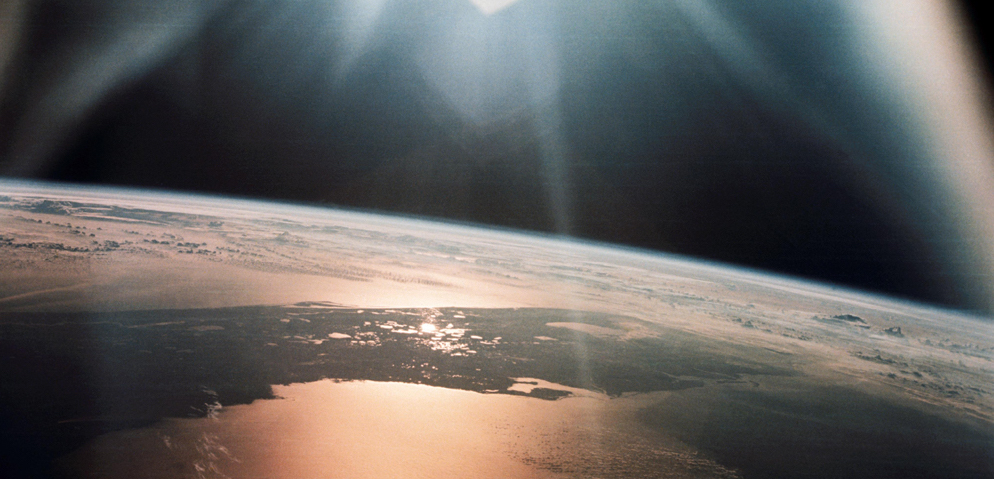
‘How to build a habitable planet’ is the title of a popular American college textbook which tells the story of the Earth from ‘The big bang to humankind’. It’s a big book – because it is a long story. All the evidence we have suggests that in its infancy the Earth was a most inhospitable planet and not very different from its near neighbours. Back then it had a transient volcanic landscape, a carbon-dioxide-rich greenhouse atmosphere and was periodically bombarded with asteroids from space. In contrast today we see a planet with mobile tectonic plates, oceans, continents, an oxygenic atmosphere and teeming with life, fundamentally different from Mercury, Mars or Venus. So, why? What is it about the history of the Earth which makes it so different now from its near neighbours?
It’s all about water
The clue to the Earth’s distinctiveness is the presence of water. Water, as we know, is the key to the evolution of life on Earth. What is less well known is the fact that water is also the key to the presence of the continents – those rocky granitic landmasses which rise above the level of the oceans. A famous scientific paper from the 1980’s captures this idea well with the title ‘No water, no granites ‐ No oceans, no continents’. The continents were first colonised by plants and subsequently by a myriad of other living organisms including ourselves. In contrast, continents are not found on any of the other planets in our solar system and even their raw material, granite, is extremely rare.
Making the continents
Initially the Earth’s water would have been present in the solar nebula (a cloud of dust and gas from an exploded star) from which the Earth and other planets formed. We know that ice is commonplace in the solar system. As the Earth was formed, water was chemically bonded into newly formed silicate minerals and became part of the planet. Subsequently it was ‘degassed’ through volcanic activity, to make the Earth’s oceans. Gradually, over time, some of that water was returned to the interior of the Earth through the dynamic processes of plate tectonics to trigger the melting of the outer layer of the Earth, which was made of basalt. This melting created low density granitic melts which solidified to form a virtually indestructible layer ‘floating’ on the denser materials of the Earth’s interior to form the continental crust. Add into this process three billion years of time and we have an incrementally grown ‘continental crust’, the home to the most advanced forms of life. At the same time it is this ‘life’ which has converted our original carbon dioxide-rich atmosphere into the present day carbon-dioxide-poor, oxygen- and nitrogen-rich atmosphere.
Water on Mars
For many years astronomers have suggested, from their observations of features such as former river channels, that there was once water on the surface Mars. This has been confirmed in the last few years with the results obtained from the NASA Curiosity rover, which has produced detailed photographs of water-lain sediments on the Martian surface. But now there is no water on Mars, so where has the water gone and why? Finding an answer to this question could provide an important clue to understand why Earth and Mars are now so different and begin to explain why some planets are water-bearing.
A new explanation for a dry Mars and a wet Earth
A recent paper in the scientific journal Nature[1]has begun to provide some answers. The planet Mars, it seems, was built in a region of the solar nebula where the activity of oxygen was higher than that in the Earth-building region. This led to planetary cores with differing iron contents, which in turn influenced the iron content of the basalt lavas found on Earth and Mars. So basalts on the surface of Mars have about twice the amount of iron found in terrestrial basalts. When basalts are buried in a thick lava pile they heat up and recrystallize to a new suite of minerals – some of which have the capacity to hold water in their internal crystal structure. Some clever calculations show that, because of their different chemical composition Martian basalts can trap much more water than terrestrial basalts and hold it in the planetary interior. Also, because Earth is much larger than Mars, any water trapped in Earth’s interior is eventually returned to the surface. All this adds up to an explanation for Mars’ missing water – it is trapped deep inside the planet, locked up in the structure of silicate minerals.
The Earth is a special place
In speaking with the senior author of this Nature paper, I sensed a feeling of wonder. This new work has shown that making an Earth-like planet which has retained water at its surface for most of its history is not quite as simple as we had previously supposed. It’s not just the distance from the sun or the size of the planet that allows a planet to form with liquid water and continents and which is conducive to the emergence of multicellular life. It also depends upon more obscure properties such as the variations in the oxygen activity of the solar nebula. And of course there may be more properties of which we are yet unaware.
In popular folklore this would be regarded as the goldilocks phenomenon – a planet that is just right for life. In cosmology it is called ‘fine-tuning’ in recognition of the extraordinary coincidences present in the structure of our Universe. Maybe our planet is also fine-tuned.
[1]Wade et al. (2017) Nature, 552, 391-394

Professor Hugh Rollinson was Course Director at the Faraday Institute and is Emeritus Professor of Earth Sciences at the University of Derby. After graduating from Oxford Hugh worked for a number of years as a field geologist in the Geological Survey of Sierra Leone. This was followed by a PhD at the University of Leicester and then a post-doc at the University of Leeds. He then joined the University of Gloucestershire and worked there for 20 years, during which time he took a three year leave of absence to work as Associate professor of geology and head of Department in the University of Zimbabwe. He then took a position as Professor of Earth Sciences and Department Head at Sultan Qaboos University in Oman for six years after which he served as Professor of Earth Sciences and Department Head at the University of Derby. Hugh’s academic interests are in the earliest part of Earth history – the first two billion years of planetary evolution and these are summarised in his text ‘Early Earth Systems’ (Wiley-Blackwell, 2007).
Hugh has had a life-long commitment to the Christian faith and has sought to integrate his beliefs with his scientific work. This has largely been through serving the local church wherever he has lived. He has a strong commitment to making the Christian faith accessible and engaging in dialogue with those who hold divergent views.